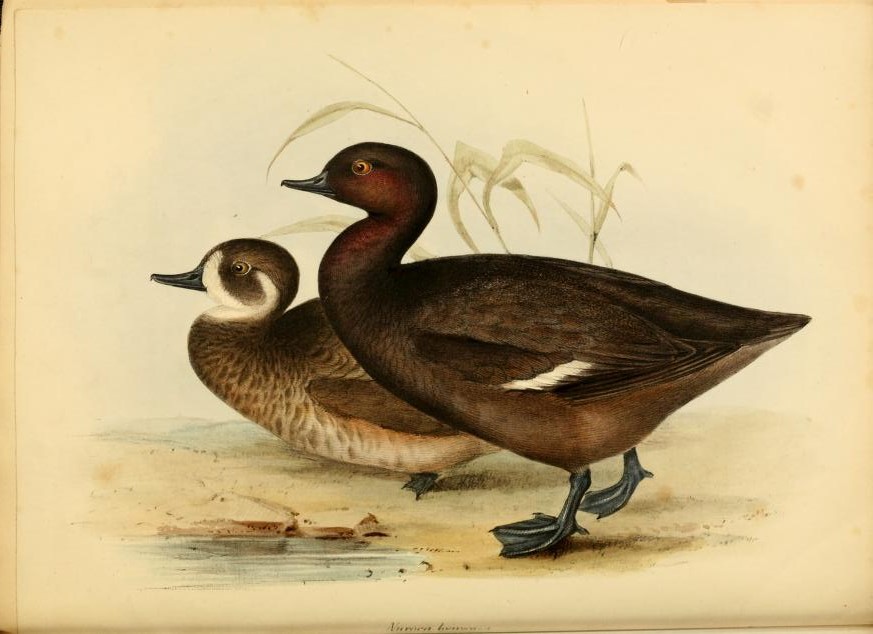Southern pochard on:
[Wikipedia]
[Google]
[Amazon]
The southern pochard (''Netta erythrophthalma'') is a species of
Monogr. Anat., 1838, p.161., pl.23.
, the African Southern Pochard, are held in the vertebrate zoology collections of National Museums Liverpool at World Museum, with accession numbers NML-VZ D832 (male adult) and NML-VZ D832a (female adult). The specimens were collected in South Africa and came to the Liverpool national collection via Thomas Campbell Eyton’s collection and the 13th Earl of Derby’s collection which was bequeathed to the city of Liverpool. There are two other syntype specimens, including NHMUK 1845.7.6.271, in the
Species text in The Atlas of Southern African Birds
southern pochard Birds of South America Birds of Sub-Saharan Africa southern pochard southern pochard {{duck-stub
duck
Duck is the common name for numerous species of waterfowl in the family (biology), family Anatidae. Ducks are generally smaller and shorter-necked than swans and goose, geese, which are members of the same family. Divided among several subfam ...
, and a member of the genus
Genus (; : genera ) is a taxonomic rank above species and below family (taxonomy), family as used in the biological classification of extant taxon, living and fossil organisms as well as Virus classification#ICTV classification, viruses. In bino ...
'' Netta''. There are two subspecies, the South American
South America is a continent entirely in the Western Hemisphere and mostly in the Southern Hemisphere, with a considerably smaller portion in the Northern Hemisphere. It can also be described as the southern Subregion#Americas, subregion o ...
(southern) pochard ''N. e. erythrophthalma'' (Wied-Neuwied, 1833) and the African (southern) pochard ''N. e. brunnea'' ( Eyton, 1838).
The South American pochard has a fragmented range and is found from Colombia
Colombia, officially the Republic of Colombia, is a country primarily located in South America with Insular region of Colombia, insular regions in North America. The Colombian mainland is bordered by the Caribbean Sea to the north, Venezuel ...
, Venezuela
Venezuela, officially the Bolivarian Republic of Venezuela, is a country on the northern coast of South America, consisting of a continental landmass and many Federal Dependencies of Venezuela, islands and islets in the Caribbean Sea. It com ...
, Brazil
Brazil, officially the Federative Republic of Brazil, is the largest country in South America. It is the world's List of countries and dependencies by area, fifth-largest country by area and the List of countries and dependencies by population ...
, Ecuador, Peru, Bolivia and Argentina
Argentina, officially the Argentine Republic, is a country in the southern half of South America. It covers an area of , making it the List of South American countries by area, second-largest country in South America after Brazil, the fourt ...
to Chile
Chile, officially the Republic of Chile, is a country in western South America. It is the southernmost country in the world and the closest to Antarctica, stretching along a narrow strip of land between the Andes, Andes Mountains and the Paci ...
. Here it occurs in a wide variety of shallow fresh waters with submerged vegetation, from the lowlands up to 3,700 metres.
The African pochard occurs from the Cape to the Ethiopian highlands on water bodies with or without emergent vegetation. They are suspected to have been strong migrants in the past but the construction of numerous farm dams seems to allow them a more sedentary lifestyle. They reach highest concentrations in Africa's central plateaus and in the south-western winter rainfall region.
Taxonomy
Two syntype specimens of ''Nyroca brunnea'' EytonMonogr. Anat., 1838, p.161., pl.23.
, the African Southern Pochard, are held in the vertebrate zoology collections of National Museums Liverpool at World Museum, with accession numbers NML-VZ D832 (male adult) and NML-VZ D832a (female adult). The specimens were collected in South Africa and came to the Liverpool national collection via Thomas Campbell Eyton’s collection and the 13th Earl of Derby’s collection which was bequeathed to the city of Liverpool. There are two other syntype specimens, including NHMUK 1845.7.6.271, in the
Natural History Museum at Tring
The Natural History Museum at Tring was the private museum of Lionel Walter, 2nd Baron Rothschild; today it is under the control of the Natural History Museum, London. It houses one of the finest collections of stuffed mammals, birds, reptil ...
.

Habits
Southern pochards are sociable and gregarious. They have been seen in groups of up to 5,000.Mating and nesting
The birds are solitary nesters, building nests out of leaves and stems on the banks of a river surrounded byvegetation
Vegetation is an assemblage of plants and the ground cover they provide. It is a general term, without specific reference to particular Taxon, taxa, life forms, structure, Spatial ecology, spatial extent, or any other specific Botany, botanic ...
. The female southern pochard lays a clutch consisting of six to fifteen eggs. The female incubates the eggs for 20 to 28 days. Once the eggs hatch, the mother leads them immediately to water.
Eating habits
The southern pochard eats mainlyaquatic plant
Aquatic plants, also referred to as hydrophytes, are vascular plants and Non-vascular plant, non-vascular plants that have adapted to live in aquatic ecosystem, aquatic environments (marine ecosystem, saltwater or freshwater ecosystem, freshwater ...
s, which it finds when diving. The adults also feed on larvae, pupae, aquatic animals and plant material.
Conservation status
The southern pochard population has been steadily declining since the 1970s. In 2016, the number of southern pochards was reported at around 25,000 in South America, but this could have been an overestimate due to a lack of data.Assessment of the Distribution and ... - Wildfowl.wwt.org.uk. https://wildfowl.wwt.org.uk/index.php/wildfowl/article/download/2657/1771References
* *External links
Species text in The Atlas of Southern African Birds
southern pochard Birds of South America Birds of Sub-Saharan Africa southern pochard southern pochard {{duck-stub